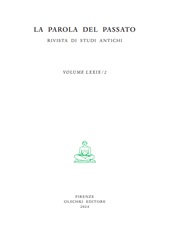Humanism, hesychasm, and the fate of Byzantium and Eastern Europe a re-reading of John Meyendorff and Gelian M. Prokhorov
P. 291-312
È comune parlare di ‘rinascimento' in relazione a diversi momenti del millennio bizantino, tra cui l'età macedone, quella comnena e quella paleologa. Quest'ultima è stata oggetto di numerose ricerche, anche perché ha attirato l'attenzione degli studiosi dell'Umanesimo e del Rinascimento nell'Europa occidentale e del Rinascimento slavo meridionale del XIV secolo. Nel mondo culturale e spirituale dell'età paleologa, in particolare nel XIV secolo, si distinguono solitamente due tendenze: da un lato, il mondo dei letterati, degli intellettuali e degli ‘umanisti'; dall'altro, il ‘partito monastico', che aveva un atteggiamento riservato, se non ostile, nei confronti della cultura secolare dei letterati. Questa seconda tendenza è rappresentata da Gregorio Palamas ed è nota come Palamismo (o Esicasmo).
Si ritiene che gli esiti di questo confronto abbiano plasmato in modo cruciale il destino di Bisanzio e dell'età successiva. La dicotomia tra ‘umanesimo' ed ‘esicasmo' è stata accettata da storici dell'arte, storici della filosofia, bizantinisti, paleografi e teologi, a rischio di diventare un cliché. L'articolo illustra la storia di questa interpretazione dalla fine del XIX secolo ai giorni nostri, analizzando in particolare gli studi-chiave di John Meyendorff e Gelian M. Prokhorov.[Testo dell'editore].
It is common to speak of a ‘renaissance' in relation to different moments of the Byzantine millennium, including the Macedonian age, the Comnenian, and the Palaeologan. The last of these has been heavily investigated, not least because it has attracted the attention of scholars of Humanism and the Renaissance in Western Europe and of the South-Slavic Renaissance of the 14th century. Scholars have also investigated the nature and fate of Byzantine Humanism/the Byzantine Renaissance on the eve of the catastrophe of 1453, asking whether it is really possible to speak of a creative and fruitful renaissance, or whether we are only dealing with fleeting and fruitless episodes and individual trajectories between East and West. In the cultural and spiritual world of the Palaeologan age, particularly in the 14th century, two tendencies are usually distinguished: on the one hand, the world of the literati, intellectuals, and «humanists»; on the other, the «monastic party», which had a reserved, if not hostile,
This second tendency is represented by Gregory Palamas and is known as Palamism (or Hesychasm). It is believed that the outcomes of this confrontation crucially shaped the destiny of Byzantium and the subsequent age. The dichotomy between «Humanism» and «Hesychasm» has been accepted by art historians, historians of philosophy, Byzantinists, palaeographers, and theologians, at the risk of becoming a cliché. The article illustrates the history of this interpretation from the end of the 19th century to the present day, analysing in particular the key studies of John Meyendorff and Gelian M. Prokhorov. [Publisher's text].
67461 characters
-
Articles from the same issue (available individually)
-
Information
DOI: 10.82026/11789
ISSN: 2610-8739


